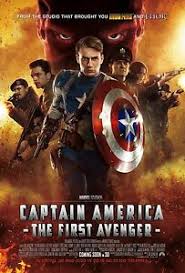
From 1939 to 1941, the first great Marvel superheroes appeared—the Sub-Mariner, The Human Torch, and Captain America. During World War II, the last-named sold a million copies per issue. After the war ended, super-heroes virtually disappeared in favor of what my mother called “funny books”, as the soldiers came home, pushed all thoughts of war to the backs of their minds, and started raising kids.
It was in March of 1941 that Captain America #1 was released, the story of Steve Rogers, a frail and sickly young man who was continually rejected for military service until a professor chose him for a secret experiment in which he was injected with “super-soldier serum” and transformed into a perfect human specimen. The Nazis, fearing an army of such soldiers, assassinated the Professor, who took the formula to his grave. Writer Joe Simon and artist Jack Kirby created the Captain America look, with the red, white, and blue uniform, the round shield, his sidekick Bucky, and his arch-enemy—the first great Marvel super-villain The Red Skull. Captain America #3 featured the first story by Stan Lee. Simon and Kirby left Marvel after an argument with publisher Martin Goodman, leaving no-one to be editor-in-chief but Stan Lee, who was 18. He would remain editor until 1972 and would revive Captain America in 1964.
In February 1944, Republic Pictures released a 15-part Captain America serial. In 1946, Marvel (called Timely Comics) introduced the All-Winners Squad, a forerunner of the Avengers featuring Captain America, Sub-Mariner, and Human Torch. In 1949 came Captain America’s Weird Tales, in which Cap descended into Hell to battle the Red Skull. Gradually, Captain America’s name and image disappeared and the transition from superhero to horror comics was complete. But in 1964, he re-appeared in Avengers #4, discovered frozen in the ice since the war. In 1965, the Avengers line-up changed. Thor, Giant-Man, Iron Man, and the Wasp were replaced by Hawkeye, Quicksilver, and the Scarlet Witch, but Captain America remained to guide them. In 1974, after Watergate, he was framed for murder by a government conspiracy called the Committee to Regain America’s Principles—CRAP. Disgusted by the revelation that the president himself was behind this, Steve Rogers quit being Captain America. He still popped up now and then: in rewritten World War II adventures; in a black costume; in the Ultimate Crossover between Marvel and D.C., in which Cap was beaten by Batman; appearing in a disillusioned state to help clean up the rubble of 9-11; and in the Civil War series, in which the Avengers were torn apart, pitting him against Iron Man. He was even shot to death, only to come back to life two years later.
The movie pretty much recapitulates the original origin story. In the present time, scientists in the arctic discover a World War II bomber emerging from the ice in a thaw. Inside, they find Captain America’s iconic shield frozen in the ice. We flash back to 1942, when Nazi officer Johann Schmidt (Hugo Weaving) and his troops steal a mysterious object called a tesseract (referred to as Odin’s Treasure) from a church, where it has been hidden for ages. In New York City, weakling Steve Rogers (Chris Evans digitally reduced in size) is rejected for military service. Making someone look older is relatively easy with make-up, making them more muscular with training or padding is common, but to make people younger or thinner than they are is a relatively new special effect, and has been pioneered in the Marvel movies. Doctor Abraham Erskine (Stanley Tucci) admires the boy’s determination and recruits him into the Strategic Scientific Reserve as part of a super-soldier experiment led by Colonel Chester Phillips (Tommy Lee Jones) and British Agent Peggy Carter (Hayley Atwell). Atwell said of her character, “She can do everything Captain America does—backwards, in high heels.”
Schmidt and Doctor Arnim Zola (Toby Jones) want to use the tesseract to power Zola’s inventions. They send assassin Heinz Kruger (Richard Armitage) to kill Professor Erskine. After the painful treatment, Rogers emerges with a new powerful body. Erskine is assassinated and Rogers uses the new body to chase down the assassin relentlessly through the streets of New York, only to have the assassin Hail Hydra and kill himself with a poison capsule. Erskine’s secret has died with him and there will be no more super-soldiers. In the beginning, Rogers (called Captain America) is used to sell war-bonds and comic books, but on a publicity tour in Italy, he heads for the front lines to rescue his friend Bucky Barnes (Sebastian Stand). He rescues 400 men and, in the process, discovers Schmidt as the Red Skull, who has taken the same serum as Rogers, but it has turned his face into a blood-red death’s head.
Captain America is given a command, which he picks from the men he has rescued: Timothy ‘Dum Dum’ Dugan (Neal McDonough), Jim Morita (Kenneth Choi), Jacques Dernier (Bruno Ricci), Gabe Jones (Derek Luke), and James Montgomery Falsworth (JJ Field)—basically the Howling Commandos of the early comics, but somewhat more diverse. They are armed and outfitted by Howard Stark (Dominic Cooper), particularly with Captain America’s vibranium shield, for an assault on Hydra, the Red Skull’s association, which has pretty much outgrown the Nazis. They stop the Skull from using weapons of mass destruction, and the villain, handling the tesseract, is pulled into a wormhole and vanishes. But Cap crashes the damaged plane sent to bomb American cities (a gloriously beautiful Flying Wing) into the arctic icecap to stop it from flying by itself into New York. Rogers awakens in a 1940s-style hospital room, but the baseball game playing on the radio is one he attended, and he knows it is all a fake. He breaks out and finds himself in Times Square in the 21st Century. Nick Fury apologizes for the deception, tells him he has been asleep for 70 years, and says the world needs him.
The movie was directed by Joe Johnson, who also directed The Rocketeer and was the Art Director for Raiders of the Lost Ark, so he appears to have a feeling for the time-period. He also designed a couple of things for George Lucas—The Millennium Falcon, The X-wing fighters, the Y-wing fighters, the Imperial Star Destroyer, the Death star, the AT-ATs, Yoda, and Boba Fett. The music was composed by Alan Silvestri of Back to the Future fame—someone else I don’t mind time-traveling with. The film received 80% on Rotten Tomatoes.
